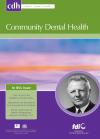Community Dental Health

- Cover Date:
- June 2006
- Print ISSN:
- 0265 539X
- Vol:
- 23
- Issue:
- 2
The impact of ï¬xed orthodontic appliances on daily life
Objective: i) To develop a measure of the impact of ï¬xed orthodontic appliances on daily life. ii) To assess the impact of ï¬xed appliances over time after initial appliance placement. iii) To investigate factors that may influence the impact of ï¬xed appliances (age, gender and socioeconomic status). Research design: Questionnaire. Clinical setting: University Dental Hospital and Hope Hospital, Manchester. Sample: Sixty-six patients, whose orthodontic appliances had just been placed. Twenty-eight patients whose orthodontic appliances were in place for at least six months were used for the reliability study. Method: The Impact of Fixed Appliances Questionnaire was developed using standard qualitative methods and pre-tested on 10 patients. This resulted in a questionnaire with nine conceptual impact sub-scales: aesthetic, functional limitation, dietary, oral hygiene, maintenance, physical, social, time constraints and travel/cost. The questionnaire was piloted on 66 patients, at the ï¬rst, second and third visits after their ï¬xed appliance had been placed, to assess the impact of ï¬xed appliances over time. Questionnaire reliability, over a one-month time interval, was assessed on 40 patients who had been in treatment for at least six months. Main outcome measure: Impact of ï¬xed appliances on daily life. Results:. The internal reliability of the questionnaire ranged from moderate to very good (Cronbach’s alpha 0.56-0.89). Test-retest reliability was stable for most subscales (intra-class correlation coefï¬cient 0.26-0.65). The questionnaire was said to have face validity and also content validity because of the method of questionnaire development through interviewing children with ï¬xed appliances. None of the subscales scores reduced over time except aesthetic impact (p< 0.05) but this was probably not a clinically signiï¬cant change. Age was the predominant variable to influence the impact of ï¬xed appliances with younger children being less affected during their daily life (p<0.05). Conclusions: The questionnaire developed in this study is a reliable tool for assessing the impact of ï¬xed appliances on the daily life of children. It is unlikely that the impact of ï¬xed appliances on daily life reduces as the patient progresses through treatment. Younger patients are probably more adaptable to treatment with ï¬xed appliances, in terms of reduced impact on daily life, so arguably treatment should be started as early as possible. This information could also be used to educate, reassure and motivate patients at the start of treatment.
Key words: Aesthetics, ï¬xed appliances, function, oral impact
- Article Price
- £15.00
- Institution Article Price
- £
- Page Start
- 67
- Page End
- 74
- Authors
- N A Mandall, S Vine, R Hulland, H V Worthington
Articles from this issue
- Title
- Pg. Start
- Pg. End
- Service quality implications of dental undergraduate outreach teaching for Primary Care Trusts in England, UK.
- 75
- 79
- Improving access to dental care in East London’s ethnic minority groups: community based, qualitative study
- 95
- 100
- The unequal burden related to the risk of oral cancer in the different regions of the Kingdom of Saudi Arabia
- 101
- 106
